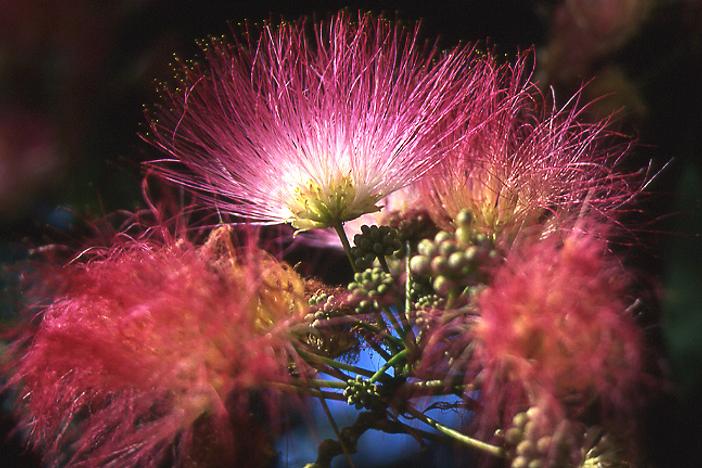Mimosa
(Albizia julibrissin f. rosea)
Mimosa (Albizia julibrissin f. rosea)
/
/

Simon Garbutt(talk·contribs)
Public domain
Image By:
Simon Garbutt(talk·contribs)
Recorded By:
Copyright:
Public domain
Copyright Notice:
Photo by: Simon Garbutt(talk·contribs) | License Type: Public domain | License URL: https://creativecommons.org/public-domain/ | Uploader: SiGarb | Publisher: Wikipedia Commons





Estimated Native Range
Summary
Albizia julibrissin f. rosea, commonly known as Mimosa or Silk Tree, is a deciduous tree native to southwestern and eastern Asia, particularly Japan. It typically grows to a height of 20-35 feet (6-11 meters) and a width of 12-20 feet (3.7-6.1 meters). The tree is known for its beautiful, feathery, fern-like foliage and showy, fluffy, pink flowers that appear in abundance from late spring to mid-summer, attracting pollinators such as bees and butterflies.
Mimosa is valued for its fast growth rate and tropical appearance, making it a popular ornamental tree in landscapes. It provides light, dappled shade and is often used in residential gardens, public parks, and along streets. The tree prefers full sun to partial shade and thrives in well-drained soils, though it can tolerate a range of soil conditions. It is relatively drought-tolerant once established. However, gardeners should be aware that Mimosa can be invasive outside its native range due to its prolific seed production and ability to re-sprout vigorously if damaged. It can also suffer from a vascular wilt disease caused by the fungus Fusarium oxysporum, which can lead to the decline and death of the tree.CC BY-SA 4.0
Mimosa is valued for its fast growth rate and tropical appearance, making it a popular ornamental tree in landscapes. It provides light, dappled shade and is often used in residential gardens, public parks, and along streets. The tree prefers full sun to partial shade and thrives in well-drained soils, though it can tolerate a range of soil conditions. It is relatively drought-tolerant once established. However, gardeners should be aware that Mimosa can be invasive outside its native range due to its prolific seed production and ability to re-sprout vigorously if damaged. It can also suffer from a vascular wilt disease caused by the fungus Fusarium oxysporum, which can lead to the decline and death of the tree.CC BY-SA 4.0
Plant Description
- Plant Type: Tree
- Height: 20-35 feet
- Width: 12-20 feet
- Growth Rate: Moderate
- Flower Color: Pink
- Flowering Season: Summer
- Leaf Retention: Deciduous
Growth Requirements
- Sun: Full Sun
- Water: Medium
- Drainage: Fast, Medium
Common Uses
Bee Garden, Bird Garden, Butterfly Garden, Drought Tolerant, Fragrant, Hummingbird Garden, Low Maintenance, Rabbit Resistant, Salt Tolerant, Showy Flowers
Natural Habitat
native to southwestern and eastern Asia, particularly Japan
Other Names
Common Names: Silktree , Silktree Albizia
Scientific Names: Albizia julibrissin f. rosea , Albizia julibrissin var. rosea , Mimosa speciosa , Albizia julibrissin var. julibrissin , Acacia isenbergiana , Acacia nemu , Albizia arunachalensis , Acacia hemu , Acacia kalkora , Albizia julibrissin f. albiflora
GBIF Accepted Name: Albizia julibrissin var. julibrissin